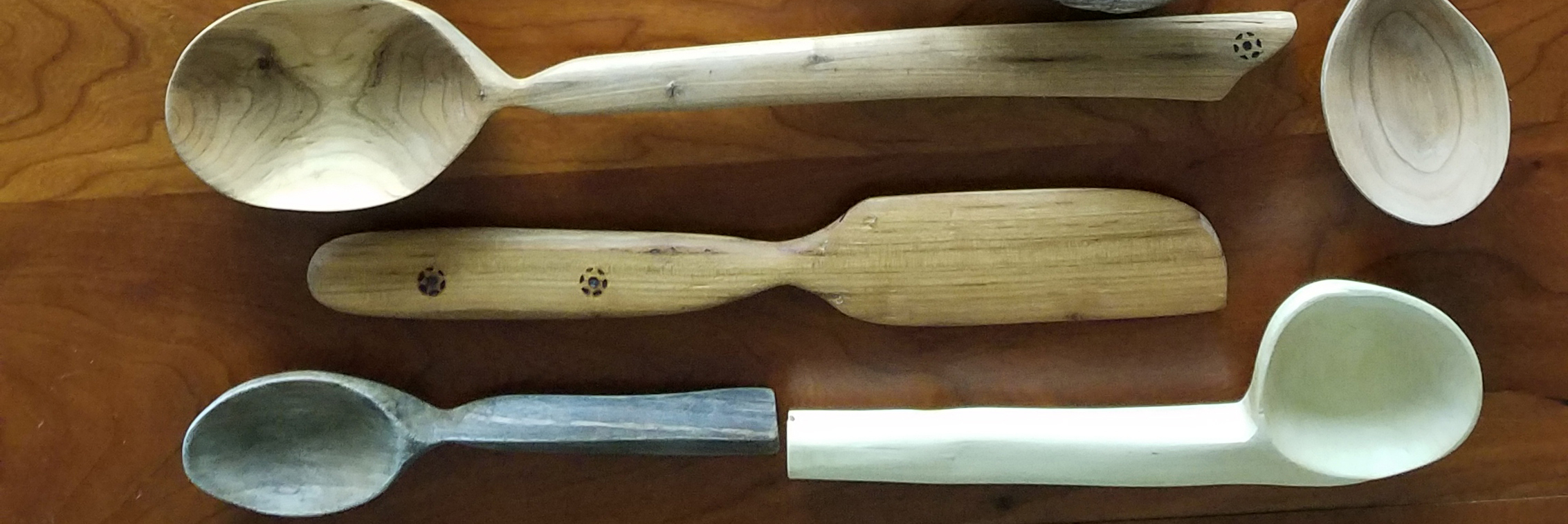In the spirit of hopefulness that spring betokens, this spring especially, I thought I would take a break from the weighty topics I have addressed in my last few Publisher’s Notes—the pandemic, the derecho, climate disruption, the death of a prairie hero—and write about why I carve spoons. To be sure, spoon carving is a quirky, some might say anachronistic, pastime, but for me serious ideas lurk beneath its surface about our ties to the natural world, the relationship between practicality and artistry, the meaning of knowledge, and the threat posed to craftsmanship by industrial capitalism.
While there is no particular connection between spoon carving and the prairie since the humble spoon is found world-wide, it has a rich history here. Native peoples were carving spoons and other wooden objects long before the arrival of Europeans, and when those Europeans came they often brought carved wooden spoons with them and continued the carving tradition here. Today, when I carve spoons, I feel a connection to those traditions and, ironically perhaps, also conjure lessons about how to live sustainably heading into the future, a big challenge facing those of us who live in the prairie region.
I do what is called “green wood carving,” meaning carving wood that has been cut fairly recently (or has been sitting in water or in a plastic bag in the freezer to prevent it from drying out). Cut wood begins to lose its moisture almost immediately. When cracks form on the cut ends of a log or branch, the wood has begun drying on the way to what is called seasoned or cured wood. Seasoned wood can also be carved, but it tends to be harder than green wood, and modern carvers are more likely to use power tools on it. One of the attractions of green wood carving for me is that all you need (I qualify this below) is a knife. Consequently, green wood carving is a quiet activity compatible with meditation, listening to music, or conversation.
My spoon carving teacher was my friend Chris. Although he often says that he was only six months ahead of me in learning the craft himself, six months is a sizable lead over no experience at all. First, Chris introduced me to Mora knives, inexpensive yet wellmade carving knives that have been manufactured in the small town of Mora, in south-central Sweden, since 1891. Chris prefers carving with the slightly longer-bladed Mora knife, whereas I have grown to like the slightly shorter-bladed one. He then taught me some of the basic strokes: the push stroke, the thumb push (for fine work) the pull stroke, and a stroke that he calls the chicken wing that is much easier to demonstrate than to describe in words. Chris finds that he uses the chicken wing a lot, whereas I am especially fond of the pull stroke. In these and other aspects of carving there is plenty of room for personal preference. In addition to the straight knife, a hook knife, with a roughly U-shaped blade, is enormously helpful for cutting out the bowl of the spoon. Mora makes those, too.
Chris started me on green wood carving by giving me a spoon “blank.” A blank is a piece of wood that has already been roughed out into the general shape of what you plan to carve. I carved my first spoon from a smooth-grained piece of apple wood. Even starting from a blank it took me five or six hours to complete, as I was operating from the old adage, “You can always remove more wood, but you can’t put any back.” (Few carving experiences are more dispiriting than getting into a good rhythm with your knife and suddenly poking a hole through the bowl of your spoon.) So, all you need to carve spoons is a straight knife and a hook knife…as long as someone provides you with blanks. If there’s no such person, you’ll need to start several steps earlier in the whole process.
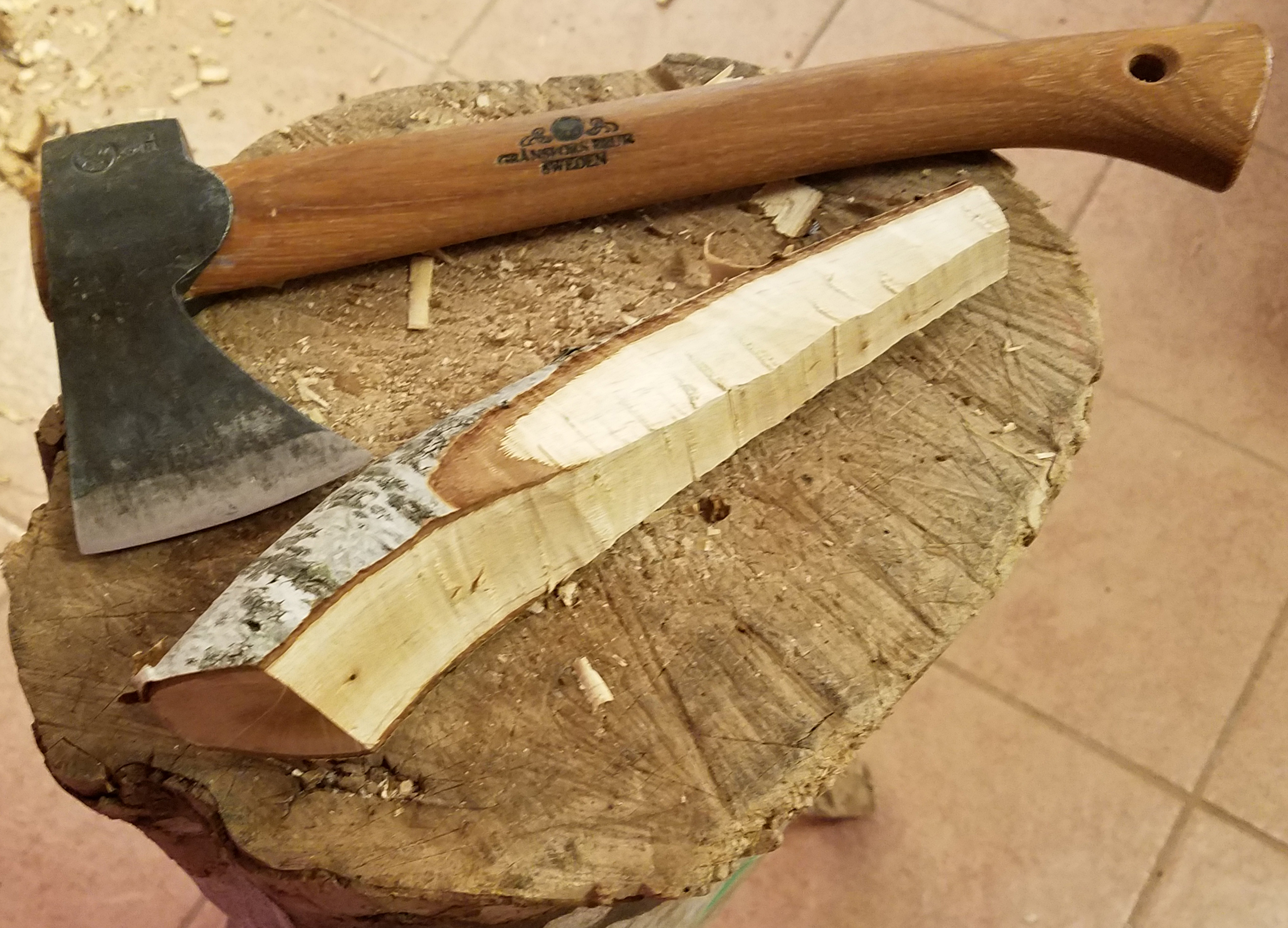
A birch-blank roughed out with an axe
First, get your hands on some green wood. This is relatively easy in rural areas but a good deal more difficult in the middle of a city. Ask around. Although any kind of wood can be carved, dense hardwoods are best for kitchen utensils. They hold their edges better during carving, resist wear, and are easier to keep clean. For spoons you’ll want a branch (or trunk) roughly two to five inches in diameter; you’ll need a saw to cut it. The length of the branch depends on the kind of spoon you want to make, maybe five inches for a personal spoon and as much as twelve inches for a cooking spoon. Then you need to split the branch along the grain using an ax, or a wedge and hammer, or (if you really get into this) a maul and a froe. You need to remove the bark and the central pith with a knife or an ax. You can then sketch the outline of the spoon you want to carve on the flat side of either half of the branch and remove the excess wood from the handle area. You can do this with a knife, but an ax is quicker. After the Mora knives, an ax is the tool I use most often in spoon carving. Chris and I are fans of the axes made by another Swedish company, Gränsfors Bruks, which has been making hand-forged axes for over a century. The axes are well-balanced, hold their edge, and seem indestructible when used properly. A final touch that Chris and I enjoy about them is that each ax bears the initials of the craftsman who made it. You can go online and find their name and sometimes a photograph.
Why Sweden? For one thing, the country has a long tradition of wood carving. A 1,000 year old tool chest unearthed in Sweden contained a tool kit strikingly similar to the tools routinely used by spoon carvers today. 1 Even more to the point, as we learn in Wille Sundqvist’s book, Swedish Carving Techniques, early in the 20th century Sweden began to recognize the detrimental effects of machine production on traditional handcrafting. Local handcraft societies sprang up, and in 1912 a National Association of Swedish Handcraft Societies was founded. Later, governmental Rural Economy Associations employed “handcraft consultants” in a few Swedish provinces. In 1990 there were 15 such paid consultants in wood, metal, and leather crafts, Wille among them. 2 Traditional handcrafts can be found in every country, of course, but Sweden has taken their preservation more seriously than most. This could explain the popularity of Swedish carving tools and the large influence of Wille and other Swedish carvers on those who’ve taken up the craft elsewhere in recent years.
Several things happen to me when I carve a spoon—or a fork, a wooden butter knife, or a bowl. The first is that I slow down. I examine the pieces of wood at hand for hints about what lies within that I could bring out. This involves knowing something about the various kinds of wood and their carving properties (apple, basswood, and walnut carve differently, for example), knowledge that comes mostly from experience. Head knowledge. It also involves thinking about design, the different possible shapes, sizes, curvatures, and decorations of what I might make. Aesthetics. I pick up the knife and slowly—because the knife is sharp—apply a pull stroke or a push stroke to the wood to begin shaping it how I imagined. Hand knowledge. Perhaps I cut too deeply on one side, spoiling the symmetry I envisioned. I stop to re-envision my design. “Every good craftsman,” writes Richard Sennett, “conducts a dialogue between concrete practices and thinking…a relation between hand and head.” 3 To which I would add heart, since I carve for the pleasure of it and to make something functional but also handsome—“the point is not to produce, but to create,” as Joshua Vogel says 4—and perhaps because I plan to present what I am making as a gift.
While I carve I am stepping away, however briefly, from the world of mass-production in plastic, metal, ceramic, paper, fiber, and wood which surrounds most of us most of the time. That world is of relatively recent origin. By contrast, the first carved wooden spoons began to appear in the Bronze Age, 3-4,000 years ago, and a spoon-like object intentionally shaped from mammoth ivory has been dated to over 20,000 years ago. 5 Other handcrafts have a much longer history. Our hominid ancestors began making stone tools at least 2.5 million years ago. Those objects in turn became part of the environment that shaped who we became. Surely Joshua Vogel is right when he says, “Making things by hand is not simply a contemporary craft movement but a fundamental part of being human.” 6
But have we in the modern world begun to lose touch with that aspect of who we are? The archaeologist Alexander Langlands, who has taught himself how to do more traditional handcrafts than I know the names for, thinks we have: “Against a rising tide of automation and increasing digital complexity, we are becoming further divorced from the very thing that defines us: we are makers, crafters of things.” 7 I don’t know if losing touch with handcrafts will harm us in the long run. I do know that, for me, carving spoons feels good.
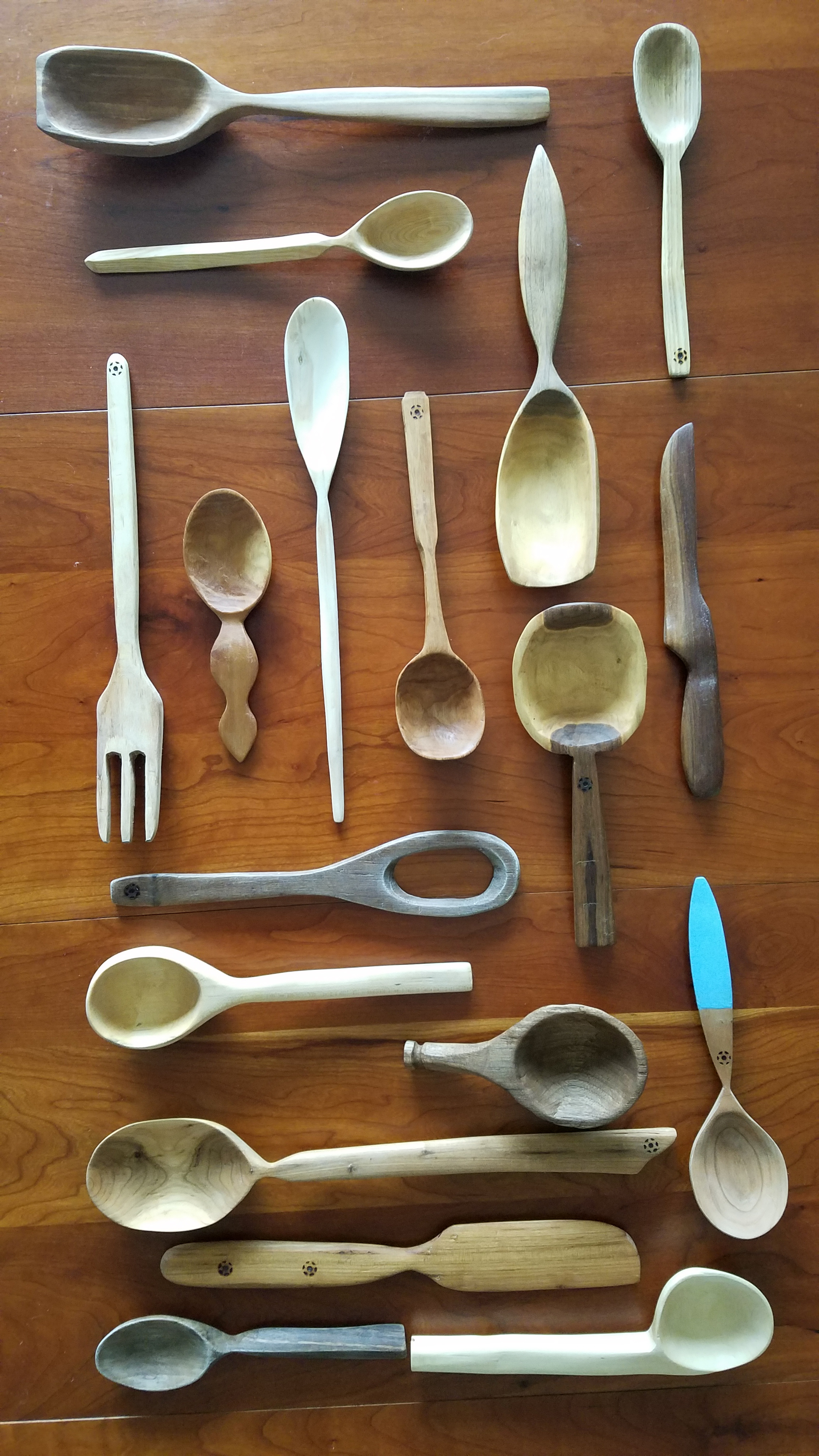
A collection of Jon Andelson’s creations
Shortly after I began carving, Chris and I initiated regular group carving sessions. Two things inspired them. Three years ago, before I ever set a knife to wood, Chris proposed to the College’s Center for Prairie Studies, of which I served as director at the time, that we host a workshop on spoon carving. He wanted to bring to the campus a carver he’d done a workshop with at the Vesterheim Norwegian-American Museum in Decorah, Iowa. A dozen students signed up for the one-day workshop, which was a success. I didn’t actually carve that day because I was too busy monitoring the tools and the refreshments and photographing the event. I grew curious, though, and a couple of months later Chris gave me my first lesson. The second thing was that for many years one of my colleagues has been hosting weekly flintknapping sessions on Friday afternoons for anyone who cared to drop by. He provides the stone, the knapping tools, and instruction for those who need it. Chris and I asked John if we could introduce a second craft to those sessions, and he agreed, so we put up flyers around campus announcing the weekly flintknapping AND spoon carving sessions.
Three or four people showed up for the first couple of sessions, and then inexplicably we began to see eight or ten every week. It was spring, and when the weather was good we worked outside; if it was inclement we were in the basement of the anthropology building. Come summer John was away, but Chris and I decided to keep the spoon carving going, and we moved the location to a lawn adjacent to the college’s vegetable garden. Students, staff members, faculty, and community members dropped by the sessions. Some tried it once or twice and decided it wasn’t for them; others got hooked, and a community of carvers began to form. In the fall we continued to meet at the garden until colder weather pushed us into an unused one-room former church located next to the garden, which the college had acquired. We wrote on a blackboard, “The Church of Cræft,” adopting an old English spelling used by Langlands as his book title. Some weeks, over thirty people showed up and we would run out of knives. I recently asked Kristen, a community member who has been one of the regulars and who became so proficient that we invited her to help instruct new carvers, why she came. “I like spoon carving because it’s very peaceful but also mindful. You’re forced into the present by the knife in your hand, but at the same time you can be around other carvers talking about life, spoons, or the weather.” Others say similar things, and I recalled Richard Sennett’s observation that the early Greeks considered craft and community to be connected. 8
So, why do I carve? I enjoy carving by myself. It allows me to turn inward, though it also connects me with nature. It gives me both focus and relaxation. It allows my hands and my head to work together. It puts me in the moment, but also connects me to the past and to the future. It mediates practicality and artistry. It teaches me to accept failure, as when I break off the tine of a fork or poke through the bowl of a spoon, or the wood cracks and I have to start over again. I like what the carver Pat Diette said: “Each spoon is a quick little journey in self-doubt, perseverance, and success.” I also enjoy carving with others. I like teaching carving. Carving—and handcraft in general—is something anyone can learn to do, irrespective of age, gender, or ethnicity, which also makes it something around which we can find connection with those not in our immediate circle. I like to carve with friends, and I have made friends through carving. Most of all I like carving with my oldest daughter, now 32, who caught the carving bug from me. Carving with her provides a precious generational connection, as does using one of my grandmother’s wooden spoons almost every day in my kitchen.
I wonder if you would enjoy carving.
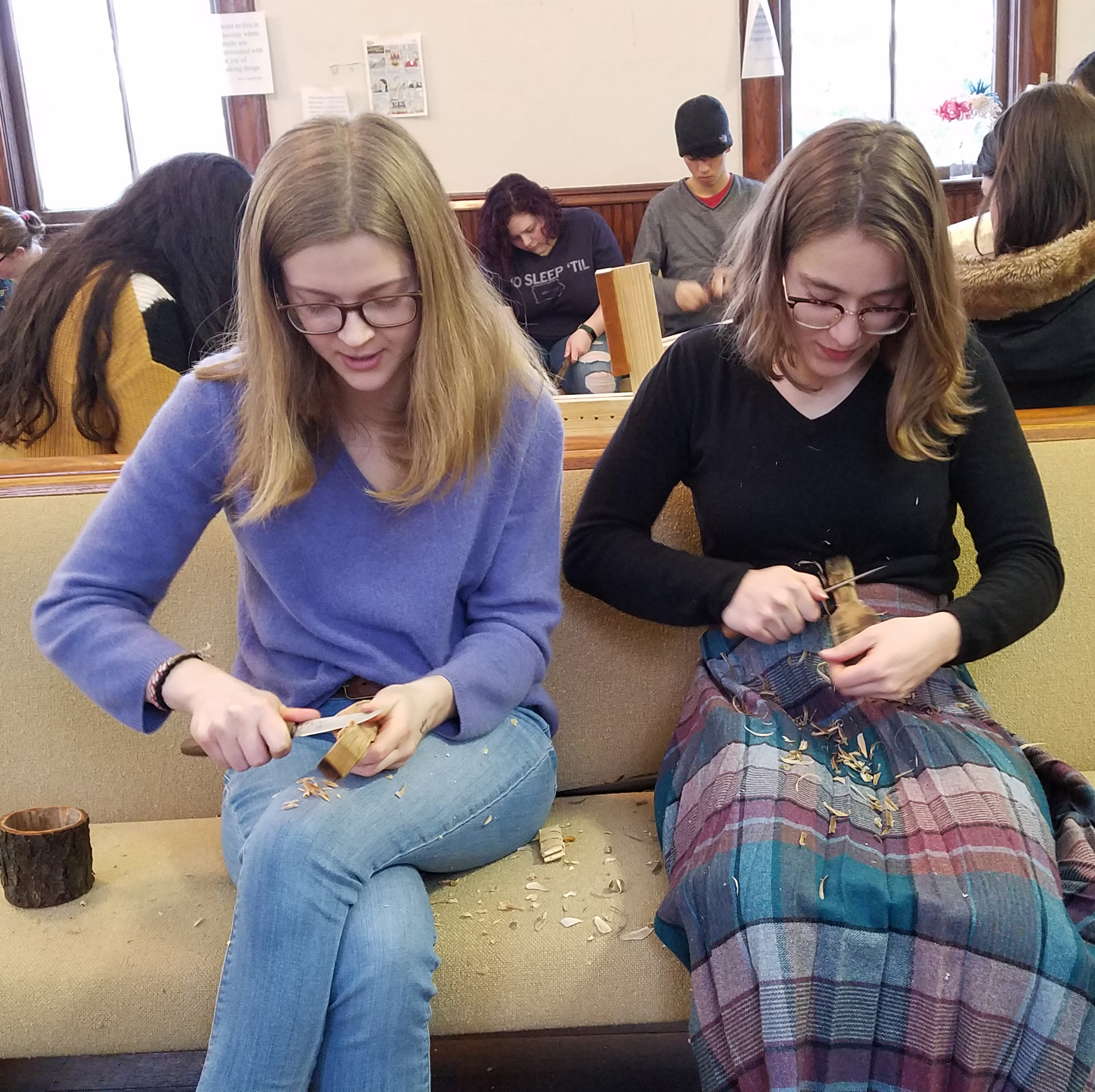
Two friends chatting and carving using thumb push (on left) and pull stroke (on right).
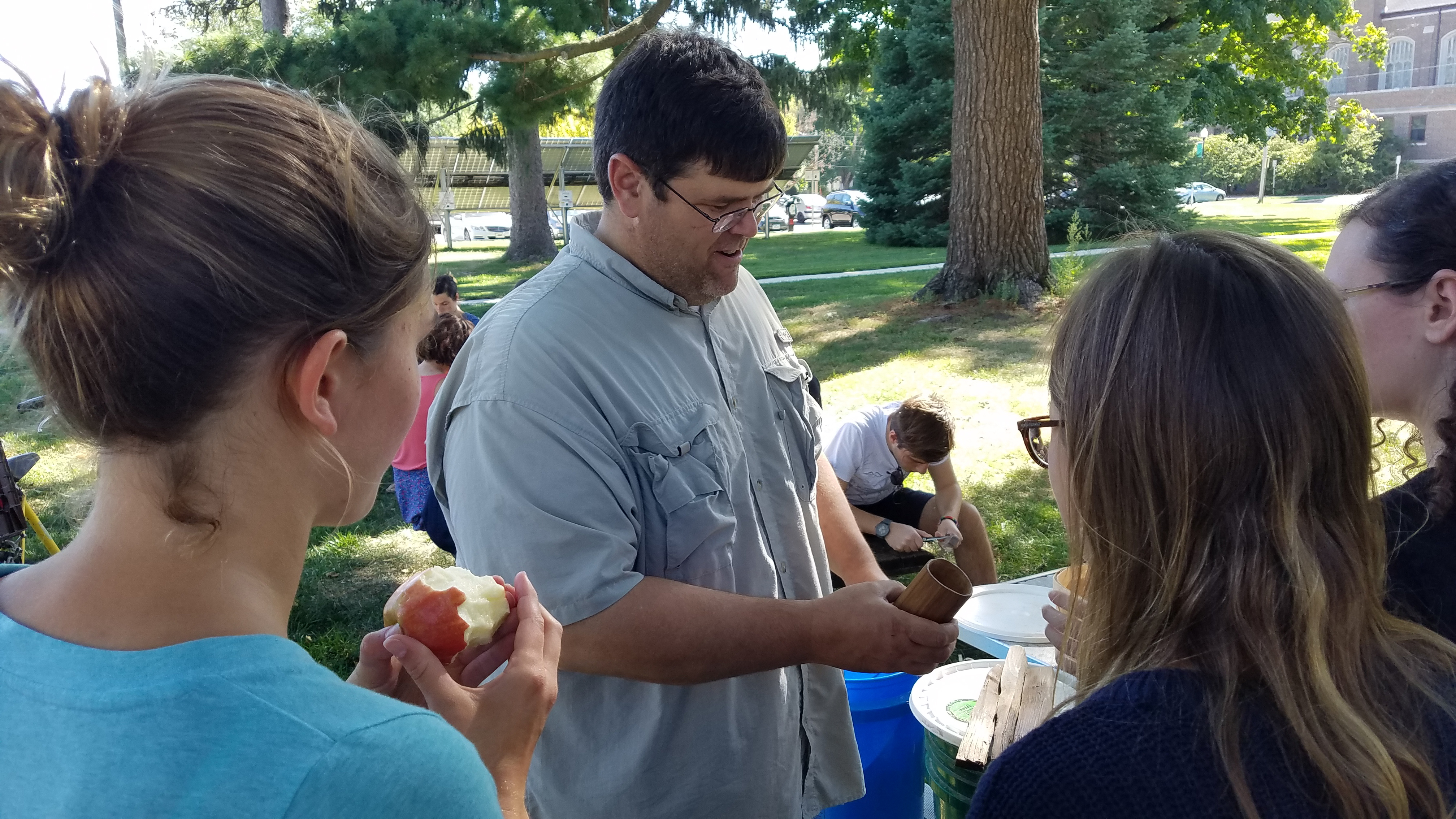
Chris Blair, co-founder of the College’s carving group, instructing some new carvers at the College Garden.
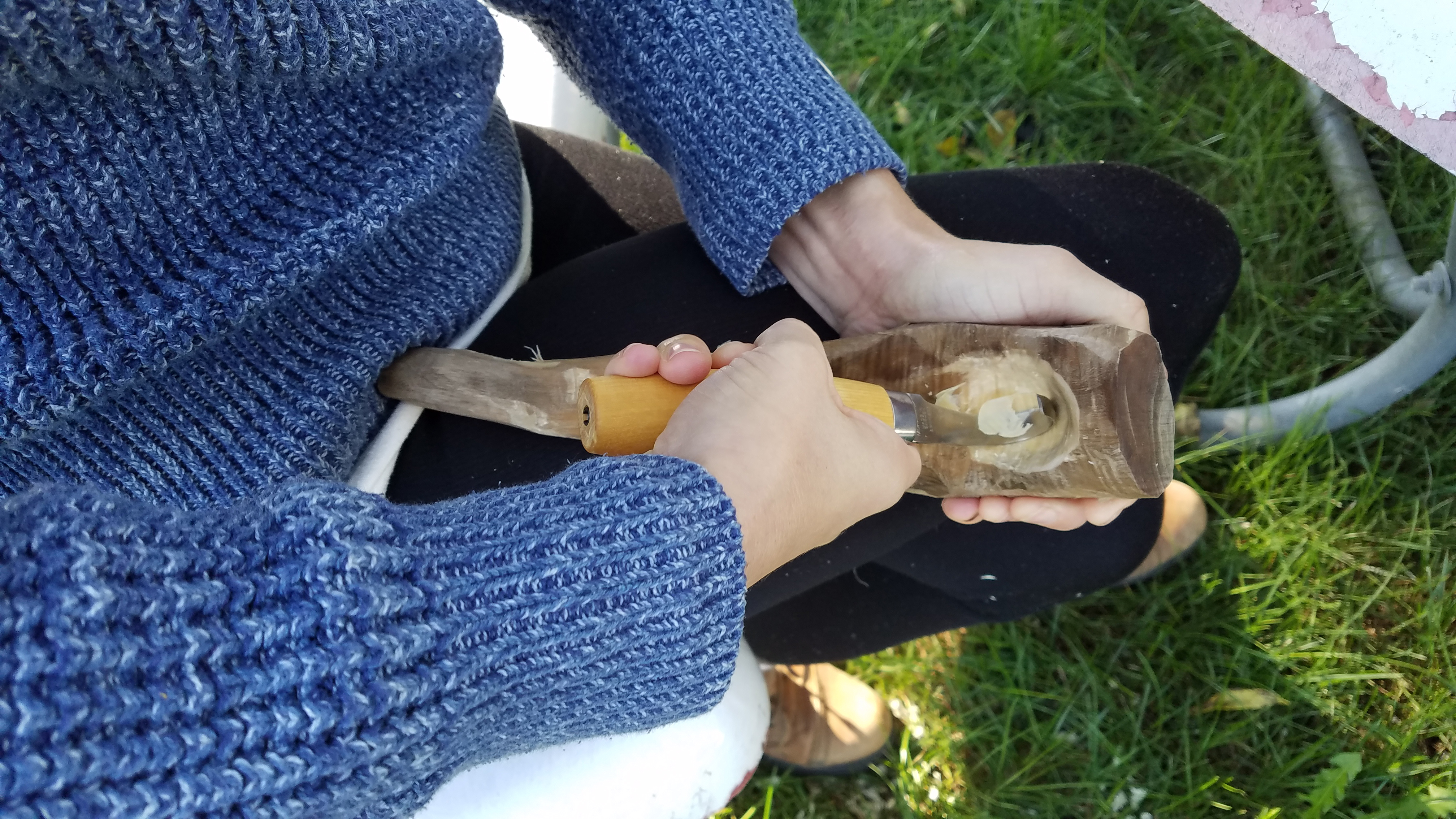
Carving out a spoon bowl with a hook knife
1 Joshua Vogel, The Artful Wooden Spoon. San Francisco: Chronicle Books (2015), p.19.
2 Wille Sundqvist, Swedish Carving Techniques. New-town, CT: The Taunton Press (1990), p.6.
3 Richard Sennett, The Craftsman. New Haven: Yale University Press (2008), p.9.
4 Vogel, p.30.
5 Vogel, p.16.
6 Vogel, p.29.
7 Alexander Langlands, Cræft: An Inquiry into the Or-igins and True Meaning of Traditional Crafts. New York: W.W. Norton & Company (2017), p.22.
8 Sennett, p.22.
